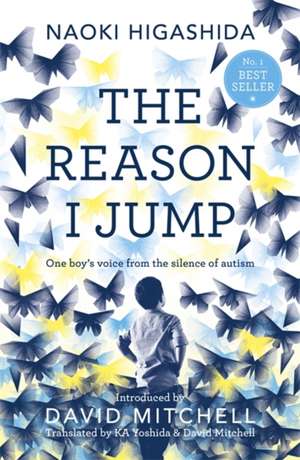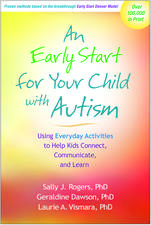The Reason I Jump: One Boy's Voice from the Silence of Autism: Waterstones Reading the 21st Century
Autor Naoki Higashidaen Limba Engleză Paperback – 24 apr 2014
The No. 1 Sunday Times and New York Times bestseller.
Written by Naoki Higashida when he was only thirteen, this remarkable book provides a rare insight into the often baffling behaviour of autistic children. Using a question and answer format, Naoki explains things like why he talks loudly or repeats the same questions, what causes him to have panic attacks, and why he likes to jump. He also shows the way he thinks and feels about his world - other people, nature, time and beauty, and himself. Abundantly proving that people with autism do possess imagination, humour and empathy, he also makes clear how badly they need our compassion, patience and understanding.
David Mitchell and his wife have translated Naoki's book so that it might help others dealing with autism and generally illuminate a little-understood condition. It gives us an exceptional chance to enter the mind of another and see the world from a strange and fascinating perspective.
The book also features eleven original illustrations, inspired by Naoki's words, by the artistic duo Kai and Sunny.
| Toate formatele și edițiile | Preț | Express |
|---|---|---|
| Paperback (2) | 47.53 lei 3-5 săpt. | +22.78 lei 6-12 zile |
| HODDER AND STOUGHTON LTD – 24 apr 2014 | 47.53 lei 3-5 săpt. | +22.78 lei 6-12 zile |
| Random House Trade – 21 mar 2016 | 98.34 lei 3-5 săpt. | |
| Hardback (1) | 130.55 lei 3-5 săpt. | |
| Random House – 26 aug 2013 | 130.55 lei 3-5 săpt. |
Din seria Waterstones Reading the 21st Century
-
 Preț: 74.85 lei
Preț: 74.85 lei - 15%
 Preț: 81.47 lei
Preț: 81.47 lei -
 Preț: 38.86 lei
Preț: 38.86 lei - 14%
 Preț: 56.55 lei
Preț: 56.55 lei - 22%
 Preț: 49.95 lei
Preț: 49.95 lei - 6%
 Preț: 55.47 lei
Preț: 55.47 lei - 23%
 Preț: 49.51 lei
Preț: 49.51 lei - 19%
 Preț: 69.83 lei
Preț: 69.83 lei - 27%
 Preț: 51.02 lei
Preț: 51.02 lei - 22%
 Preț: 55.36 lei
Preț: 55.36 lei - 15%
 Preț: 59.94 lei
Preț: 59.94 lei - 15%
 Preț: 109.57 lei
Preț: 109.57 lei -
 Preț: 71.62 lei
Preț: 71.62 lei - 24%
 Preț: 53.43 lei
Preț: 53.43 lei - 22%
 Preț: 50.40 lei
Preț: 50.40 lei - 30%
 Preț: 49.75 lei
Preț: 49.75 lei - 20%
 Preț: 57.69 lei
Preț: 57.69 lei - 21%
 Preț: 56.42 lei
Preț: 56.42 lei - 33%
 Preț: 34.87 lei
Preț: 34.87 lei - 22%
 Preț: 50.99 lei
Preț: 50.99 lei - 21%
 Preț: 67.38 lei
Preț: 67.38 lei - 22%
 Preț: 56.07 lei
Preț: 56.07 lei - 17%
 Preț: 41.51 lei
Preț: 41.51 lei - 24%
 Preț: 48.23 lei
Preț: 48.23 lei -
 Preț: 70.07 lei
Preț: 70.07 lei -
 Preț: 69.20 lei
Preț: 69.20 lei - 16%
 Preț: 47.67 lei
Preț: 47.67 lei - 14%
 Preț: 56.24 lei
Preț: 56.24 lei -
 Preț: 67.10 lei
Preț: 67.10 lei -
 Preț: 69.07 lei
Preț: 69.07 lei - 22%
 Preț: 50.81 lei
Preț: 50.81 lei - 16%
 Preț: 58.59 lei
Preț: 58.59 lei -
 Preț: 58.49 lei
Preț: 58.49 lei - 41%
 Preț: 43.05 lei
Preț: 43.05 lei -
 Preț: 56.83 lei
Preț: 56.83 lei -
 Preț: 82.33 lei
Preț: 82.33 lei - 23%
 Preț: 44.35 lei
Preț: 44.35 lei -
 Preț: 51.44 lei
Preț: 51.44 lei -
 Preț: 57.14 lei
Preț: 57.14 lei -
 Preț: 70.22 lei
Preț: 70.22 lei - 20%
 Preț: 41.86 lei
Preț: 41.86 lei - 22%
 Preț: 55.98 lei
Preț: 55.98 lei - 23%
 Preț: 49.60 lei
Preț: 49.60 lei - 23%
 Preț: 39.67 lei
Preț: 39.67 lei - 21%
 Preț: 56.51 lei
Preț: 56.51 lei -
 Preț: 73.70 lei
Preț: 73.70 lei - 23%
 Preț: 53.77 lei
Preț: 53.77 lei - 45%
 Preț: 39.19 lei
Preț: 39.19 lei -
 Preț: 69.72 lei
Preț: 69.72 lei
Preț: 47.53 lei
Preț vechi: 63.01 lei
-25% Nou
9.09€ • 9.50$ • 7.53£
Carte disponibilă
Livrare economică 14-28 martie
Livrare express 27 februarie-05 martie pentru 32.77 lei
Specificații
ISBN-10: 1444776770
Pagini: 178
Ilustrații: 10 illustrations
Dimensiuni: 131 x 197 x 15 mm
Greutate: 0.18 kg
Editura: HODDER AND STOUGHTON LTD
Colecția Sceptre
Seria Waterstones Reading the 21st Century
Notă biografică
David Mitchell is the author of the novels Ghostwritten, number9dream, Cloud Atlas, Black Swan Green and The Thousand Autumns of Jacob de Zoet. He has been shortlisted twice for the Man Booker Prize and won several awards for his writing. KA Yoshida was born in Yamaguchi, Japan, and specialised in English Poetry at Notre Dame Seishin University.
Recenzii
“The Reason I Jump is a Rosetta stone. . . . I had to keep reminding myself that the author was a thirteen-year-old boy when he wrote this . . . because the freshness of voice coexists with so much wisdom. This book takes about ninety minutes to read, and it will stretch your vision of what it is to be human.”—Andrew Solomon, The Times (U.K.)
“We have our received ideas, we believe they correspond roughly to the way things are, then a book comes along that simply blows all this so-called knowledge out of the water. This is one of them. . . . An entry into another world.”—Daily Mail (U.K.)
“Every page dismantles another preconception about autism. . . . Once you understand how Higashida managed to write this book, you lose your heart to him.”—New Statesman (U.K.)
“Astonishing. The Reason I Jump builds one of the strongest bridges yet constructed between the world of autism and the neurotypical world. . . . There are many more questions I’d like to ask Naoki, but the first words I’d say to him are ‘thank you.’”—The Sunday Times (U.K.)
“This is a guide to what it feels like to be autistic. . . . In Mitchell and Yoshida’s translation, [Higashida] comes across as a thoughtful writer with a lucid simplicity that is both childlike and lyrical. . . . Higashida is living proof of something we should all remember: in every autistic child, however cut off and distant they may outwardly seem, there resides a warm, beating heart.”—Financial Times (U.K.)
“Higashida’s child’s-eye view of autism is as much a winsome work of the imagination as it is a user’s manual for parents, carers and teachers. . . . This book gives us autism from the inside, as we have never seen it. . . . [Higashida] offers readers eloquent access into an almost entirely unknown world.”—The Independent (U.K.)
“Like millions of parents confronted with autism, Mitchell and his wife found themselves searching for answers and finding few that were satisfactory. Help, when it arrived, came not from some body of research but from the writings of a Japanese schoolboy, Naoki Higashida. The Reason I Jump . . . is a book that acts like a door to another logic, explaining why an autistic child might flap his hands in front of his face, disappear suddenly from home—or jump.”—The Telegraph (U.K.)
“This is a wonderful book. I defy anyone not to be captivated, charmed and uplifted by it.”—Evening Standard (London)
“Whether or not you have experienced raising a child who is autistic . . . this little book, which packs immeasurable honesty and truth into its pages, will simply detonate any illusions, assumptions, and conclusions you've made about the condition. . . . What Higashida has done by communicating his reality is to offer carers a way forward and offer teachers new ways of working with the children, and thus opening up and expanding the possibilities for autistic kids to feel less alone. All that in less than 200 pages? What an accomplishment.”—The Herald (Dublin)
“The Reason I Jump is an enlightening, touching and heart-wrenching read. Naoki asks for our patience and compassion—after reading his words, it’s impossible to deny that request.”—Yorkshire Post (U.K.)
“The Reason I Jump is a wise, beautiful, intimate and courageous explanation of autism as it is lived every day by one remarkable boy. Naoki Higashida takes us ‘behind the mirror’—his testimony should be read by parents, teachers, siblings, friends, and anybody who knows and loves an autistic person. I only wish I’d had this book to defend myself when I was Naoki’s age.”—Tim Page, author of Parallel Play and professor of journalism and music at the University of Southern California
“[Higashida] illuminates his autism from within. . . . Anyone struggling to understand autism will be grateful for the book and translation.”—Kirkus Reviews
Extras
David Mitchell
The thirteen-year-old author of this book invites you, his reader, to imagine a daily life in which your faculty of speech is taken away. Explaining that you’re hungry, or tired, or in pain, is now as beyond your powers as a chat with a friend. I’d like to push the thought-experiment a little further. Now imagine that after you lose your ability to communicate, the editor-in-residence who orders your thoughts walks out without notice. The chances are that you never knew this mind-editor existed, but now that he or she has gone, you realize too late how the editor allowed your mind to function for all these years. A dam-burst of ideas, memories, impulses and thoughts is cascading over you, unstoppably. Your editor controlled this flow, diverting the vast majority away, and recommending just a tiny number for your conscious consideration. But now you’re on your own.
Now your mind is a room where twenty radios, all tuned to different stations, are blaring out voices and music. The radios have no off-switches or volume controls, the room you’re in has no door or window, and relief will come only when you’re too exhausted to stay awake. To make matters worse, another hitherto unrecognized editor has just quit without notice—your editor of the senses. Suddenly sensory input from your environment is flooding in too, unfiltered in quality and overwhelming in quantity. Colors and patterns swim and clamor for your attention. The fabric softener in your sweater smells as strong as air freshener fired up your nostrils. Your comfy jeans are now as scratchy as steel wool. Your vestibular and proprioceptive senses are also out of kilter, so the floor keeps tilting like a ferry in heavy seas, and you’re no longer sure where your hands and feet are in relation to the rest of you. You can feel the plates of your skull, plus your facial muscles and your jaw; your head feels trapped inside a motorcycle helmet three sizes too small which may or may not explain why the air conditioner is as deafening as an electric drill, but your father—who’s right here in front of you—sounds as if he’s speaking to you from a cellphone, on a train going through lots of short tunnels, in fluent Cantonese. You are no longer able to comprehend your mother tongue, or any tongue: from now on, all languages will be foreign languages. Even your sense of time has gone, rendering you unable to distinguish between a minute and an hour, as if you’ve been entombed in an Emily Dickinson poem about eternity, or locked into a time-bending SF film. Poems and films, however, come to an end, whereas this is your new ongoing reality. Autism is a lifelong condition.
Thanks for sticking to the end, though the real end, for most of us, would involve sedation and being forcibly hospitalized, and what happens next it’s better not to speculate. Yet for those people born onto the autistic spectrum, this unedited, unfiltered and scary-as-all-hell reality is home. The functions that genetics bestows on the rest of us—the “editors”—as a birthright, people with autism must spend their lives learning how to simulate. It is an intellectual and emotional task of Herculean, Sisyphean and Titanic proportions, and if the autistic people who undertake it aren’t heroes, then I don’t know what heroism is, never mind that the heroes have no choice. Sentience itself is not so much a fact to be taken for granted, but a brickby-brick, self-built construct requiring constant maintenance. As if this wasn’t a tall enough order, people with autism must survive in an outside world where “special needs” is playground slang for “retarded,” where melt-downs and panic attacks are viewed as tantrums, where disability allowance claimants are assumed by many to be welfare scroungers, and where British foreign policy can be described as “autistic” by a French minister. (M. Lellouche
apologized later, explaining that he never dreamed that the adjective could have caused offense. I don’t doubt it.)
Autism is no cakewalk for the child’s parents or carers either, and raising an autistic son or daughter is no job for the fainthearted—in fact, faintheartedness is doomed by the fi rst niggling doubt that there’s Something Not Quite Right about your sixteen-month-old. On Diagnosis Day, a child psychologist hands down the verdict with a worn-smooth truism about your son still being the same little guy that he was before this life-redefining news was confirmed. Then you run the gauntlet of other people’s reactions: “It’s just so sad”; “What, so he’s going to be like Dustin Hoffman in Rain Man?”; “I hope you’re not going to take this so-called ‘diagnosis’ lying down!”; and my favorite, “Yes, well, I told my pediatrician where to go stick his MMR jabs.” Your first contacts with most support agencies will put the last nails in the coffin of faintheartedness, and graft onto you a layer of scar tissue and cynicism as thick as rhino hide. There are gifted and resourceful people working in autism support, but with depressing regularity government policy appears to be about Band-Aids and fig leaves, and not about realizing the potential of children with special needs and helping them become long-term net contributors to society. The scant silver lining is that medical theory is no longer blaming your wife for causing the autism by being a “Refrigerator Mother” as it did not so long ago (Refrigerator Fathers were unavailable for comment) and that you don’t live in a society where people with autism are believed to be witches or devils and get treated accordingly.
Where to turn to next? Books. (You’ll have started already, because the first reaction of friends and family desperate to help is to send clippings, Web links and literature, however tangential to your own situation.) Special Needs publishing is a jungle. Many How to Help Your Autistic Child manuals have a doctrinaire spin, with generous helpings of © and ™. They may contain usable ideas, but reading them can feel depressingly like being asked to join a political party or a church. The more academic texts are denser, more cross-referenced and rich in pedagogy and abbreviations. Of course it’s good that academics are researching the field, but often the gap between the theory and what’s unraveling on your kitchen floor is too wide to bridge.
Another category is the more confessional memoir, usually written by a parent, describing the impact of autism on the family and sometimes the positive effect of an unorthodox treatment. These memoirs are media-friendly and raise the profile of autism in the marketplace of worthy causes, but I have found their practical use to be limited, and in fairness they usually aren’t written to be useful. Every autistic person exhibits his or her own variation of the condition—autism is more like retina patterns than measles—and the more unorthodox the treatment for one child, the less likely it is to help another (mine, for example).
A fourth category of autism book is the “autism autobiography” written by insiders on the autistic spectrum, the most famous example being Thinking in Pictures by Temple Grandin. For sure, these books are often illuminating, but almost by definition they tend to be written by adults who have already worked things out, and they couldn’t help me where I needed help most: to understand why my three-year-old was banging his head against the floor; or flapping his fingers in front of his eyes at high speed; or suffering from skin so sensitive that he couldn’t sit or lie down; or howling with grief for forty-five minutes when the Pingu DVD was too scratched for the DVD player to read it. My reading provided theories, angles, anecdotes and guesses about these challenges, but without reasons all I could do was look on, helplessly.
One day my wife received a remarkable book she had ordered from Japan called The Reason I Jump. Its author, Naoki Higashida, was born in 1992 and was still in junior high school when the book was published. Naoki’s autism is severe enough to make spoken communication pretty much impossible, even now. But thanks to an ambitious teacher and his own persistence, he learned to spell out words directly onto an alphabet grid. A Japanese alphabet grid is a table of the basic forty Japanese hiragana letters, and its English counterpart is a copy of the qwerty keyboard, drawn onto a card and laminated. Naoki communicates by pointing to the letters on these grids to spell out whole words, which a helper at his side then transcribes. These words build up into sentences, paragraphs and entire books. “Extras” around the side of the grids include numbers, punctuation, and the words finished, yes and no. (Although Naoki can also write and blog directly onto a computer via its keyboard, he finds the lower-tech alphabet grid a “steadier handrail” as it offers fewer distractions and helps him to focus.) Even in primary school this method enabled him to communicate with others, and compose poems and story books, but it was his explanations about why children with autism do what they do that were, literally, the answers that we had been waiting for. Composed by a writer still with one foot in childhood, and whose autism was at least as challenging and life-altering as our son’s, The Reason I Jump was a revelatory godsend. Reading it felt as if, for the first time, our own son was talking to us about what was happening inside his head, through Naoki’s words.
The book goes much further than providing information, however: it offers up proof that locked inside the helpless-seeming autistic body is a mind as curious, subtle and complex as yours, as mine, as anyone’s. During the 24/7 grind of being a carer, it’s all too easy to forget the fact that the person you’re doing so much for is, and is obliged to be, more resourceful than you in many respects. As the months turn into years “forgetting” can become “disbelieving,” and this lack of faith makes both the carer and the cared-for vulnerable to negativities. Naoki Higashida’s gift is to restore faith: by demonstrating intellectual acuity and spiritual curiosity; by analysis of his environment and his condition; and by a puckish sense of humor and a drive to write fiction. We’re not talking signs or hints of these mental propensities: they’re already here, in the book which (I hope) you’re about to read. If that weren’t enough, The Reason I Jump unwittingly discredits the doomiest item of received wisdom about autism—that people with autism are antisocial loners who lack empathy with others. Naoki Higashida reiterates repeatedly that no, he values the company of other people very much. But because communication is so fraught with problems, a person with autism tends to end up alone in a corner, where people then see him or her and think, Aha, classic sign of autism, that. Similarly, if people with autism are oblivious to other people’s feelings, how could Naoki testify that the most unendurable aspect of autism is the knowledge that he makes other people stressed out and depressed? How could he write a story (entitled “I’m Right Here” and included at the end of the book) boasting characters who display a range of emotions and a plot designed to tweak the tear glands? Like all storytelling mammals, Naoki is anticipating his audience’s emotions and manipulating them. That is empathy. The conclusion is that both emotional poverty and an aversion to company are not symptoms of autism but consequences of autism, its harsh lockdown on self-expression and society’s near-pristine ignorance about what’s happening inside autistic heads.
For me, all the above is transformative, life-enhancing knowledge. When you know that your kid wants to speak with you, when you know that he’s taking in his surroundings every bit as attentively as your nonautistic daughter, whatever the evidence to the contrary, then you can be ten times more patient, willing, understanding and communicative; and ten times better able to help his development. It is no exaggeration to say that The Reason I Jump allowed me to round a corner in our relationship with our son. Naoki Higashida’s writing administered the kick I needed to stop feeling sorry for myself, and start thinking how much tougher life was for my son, and what I could do to make it less tough. Virtuous spirals are as wonderful in special-needs parenting as anywhere else: your expectations for your child are raised; your stamina to get through the rocky patches is strengthened; and your child senses this, and responds. My wife began to work on an informal translation of Naoki’s book into English so that our son’s other carers and tutors could read it, as well as a few friends who also have sons and daughters with autism in our corner of Ireland. But after discovering through Web groups that other expat Japanese mothers of children with autism were frustrated by the lack of a translation into English, we began to wonder if there might not be a much wider audience for Naoki Higashida. This English translation of The Reason I Jump is the result.
The author is not a guru, and if the answers to a few of the questions may seem a little sparse, remember he was only thirteen when he wrote them. Even when he can’t provide a short, straight answer—such as to the question “Why do you like lining up your toys so obsessively?”—what he has to say is still worthwhile. Naoki Higashida has continued to write, keeps a nearly daily blog, has become well known in autism advocacy circles and has been featured regularly in the Japanese Big Issue. He says that he aspires to be a writer, but it’s obvious to me that he already is one—an honest, modest, thoughtful writer, who has won over enormous odds and transported first-hand knowledge from the severely autistic mind into the wider world; a process as taxing for him as, say, the act of carrying water in cupped palms across a bustling Times Square or Piccadilly Circus would be to you or me. The three characters used for the word “autism” in Japanese signify “self,” “shut” and “illness.” My imagination converts these characters into a prisoner locked up and forgotten inside a solitary confinement cell waiting for someone, anyone, to realize he or she is in there. The Reason I Jump knocks out a brick in the
wall.



















